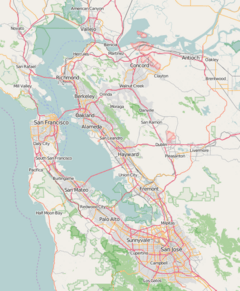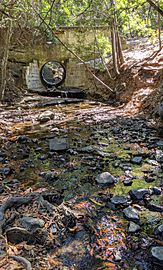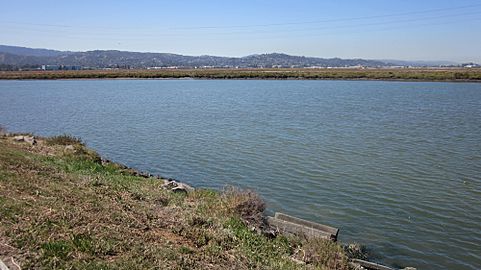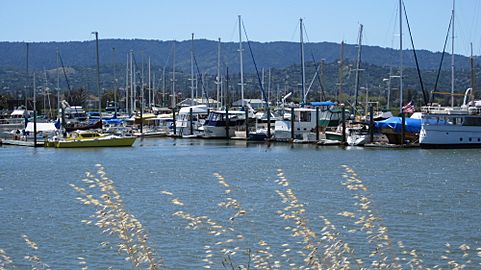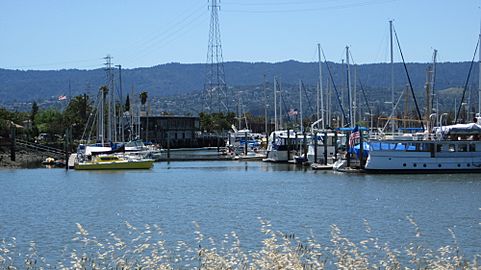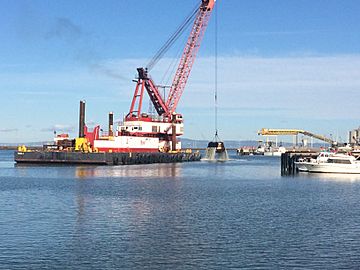Redwood Creek (San Mateo County) facts for kids
Quick facts for kids Redwood Creek |
|
|---|---|
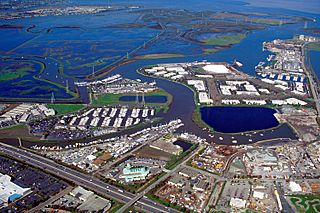
Aerial view of the mouth of Redwood Creek on San Francisco Bay at the port of Redwood City, California
|
|
|
Location of the Redwood Creek estuary in San Francisco Bay
|
|
| Country | United States |
| State | California |
| Region | San Mateo County |
| City | Redwood City, California |
| Physical characteristics | |
| Main source | Arroyo Ojo De Agua Redwood City 37°27′27.8″N 122°15′58.9″W / 37.457722°N 122.266361°W |
| 2nd source | Arroyo Salinas Woodside, California 37°26′35.4″N 122°15′39.4″W / 37.443167°N 122.260944°W |
| River mouth | Redwood Slough 37°31′35.1″N 122°11′46.4″W / 37.526417°N 122.196222°W |
| Basin features | |
| Tributaries |
|
Redwood Creek is a stream about 9.5 miles (15.3 km) long. It flows through San Mateo County, California, in the United States. This creek eventually empties into the southern part of San Francisco Bay. The Port of Redwood City is a very important port. It is the biggest deepwater port in the South San Francisco Bay. This port is located on the east side of Redwood Creek. Near its mouth, the creek naturally becomes a deep channel.
Contents
History of Redwood Creek
The creek and the city of Redwood City got their names from the giant coast redwood trees. These trees used to grow nearby. In the past, there was a big lumber industry here.
Early Uses of the Creek
In 1851, people found a deep channel of water. This channel went inland from San Francisco Bay. It reached what is now Redwood City. This channel was named Redwood Creek. Lumber companies used it to ship wood and logs. They sent them from the redwood forests to San Francisco.
Shipbuilding Industry
A shipbuilding industry soon started in the area. The first schooner, a type of sailing ship, was built in 1851. It was named "Redwood." Building wooden ships was an active business for many years. The last wooden ship, called the "Perseverance," was launched in 1883. Shipbuilding had a comeback in 1918. That's when the first concrete ship in America, the SS Faith, was built here.
Understanding the Redwood Creek Watershed
A watershed is an area of land. All the water from rain and snow in that area drains into a specific stream, river, or lake.
Where Redwood Creek Begins
Redwood Creek starts in the Woodside Glens neighborhood. This is in Woodside, California. It begins just south of Interstate 280. The creek then flows under Interstate 280. It continues along the west side of Woodside Road. It also passes through the Menlo Country Club.
The Creek's Journey Through Redwood City
When the creek reaches Alameda de las Pulgas, it becomes a concrete channel. This channel helps control the water flow. It then briefly appears above ground near El Camino Real. After that, it goes into underground pipes in downtown Redwood City. The main stream that feeds into Redwood Creek is called Arroyo Ojo de Agua. This tributary joins Redwood Creek underground near Broadway Street. As the creek goes under US Highway 101, it becomes a tidal channel. This means the water level changes with the ocean tides.
Mudflats and Marshes
Near the mouth of Redwood Creek, you can find large mudflats and marsh areas. These are important natural habitats. Several smaller channels, called sloughs, connect to Redwood Creek. The biggest one is Westpoint Slough.
Wildlife and Plants in Redwood Creek
The area around Redwood Creek is home to different types of plants and animals. Scientists have studied the creek to learn more about its natural life.
Fish in the Creek
In 1981, scientists looked for steelhead trout (Oncorhynchus mykiss) in Redwood Creek. They also checked its tributary, Arroyo Ojo de Agua. However, they did not find any trout during their search. We don't know if trout lived in the creek a long time ago.
Special Plants in the Area
At Stulsaft Park, along the Arroyo de Ojo Agua tributary, a special plant was found in 2007. This plant is the endangered Fountain thistle (Cirsium fontinale var. fontinale). It grows in wet areas with a special type of soil called serpentine soil. In Stulsaft Park, it grows in an open area within a coffeeberry and bay laurel forest. These plants can grow up to 6 feet tall. They are very rare and are only found in a few places in San Mateo County.
Restoring the Creek Banks
In August 2018, a group called Grassroots Ecology worked with the San Jose Conservation Corps. They also partnered with Redwood City. Their project was to remove about 40 non-native Canary Island date palm trees. These trees were growing along a part of Redwood Creek in the downtown area. Some of these palm trees were very wide, over 5 feet across. They had taken over the creek banks. They also blocked the view of the creek for people.
After removing the palm trees, native plants were put back along the creek banks. This helps increase the different types of plants and animals in the area. It also made the creek more visible. This was helpful for ambulances going to the nearby hospital.
Gallery
|


